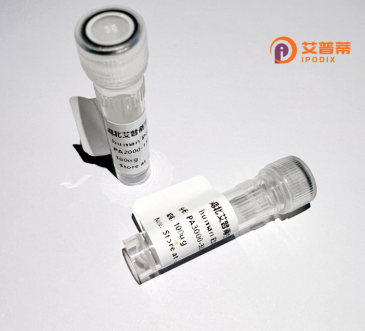
| 纯度 | >90%SDS-PAGE. |
| 种属 | Human |
| 靶点 | MS4A8B |
| Uniprot No | Q9BY19 |
| 内毒素 | < 0.01EU/μg |
| 表达宿主 | E.coli |
| 表达区间 | 1-250 aa |
| 活性数据 | MNSMTSAVPVANSVLVVAPHNGYPVTPGIMSHVPLYPNSQPQVHLVPGNPPSLVSNVNGQ PVQKALKEGKTLGAIQIIIGLAHIGLGSIMATVLVGEYLSISFYGGFPFWGGLWFIISGS LSVAAENQPYSYCLLSGSLGLNIVSAICSAVGVILFITDLSIPHPYAYPDYYPYAWGVNP GMAISGVLLVFCLLEFGIACASSHFGCQLVCCQSSNVSVIYPNIYAANPVITPEPVTSPP SYSSEIQANK |
| 分子量 | 26.2 kDa |
| 蛋白标签 | His tag N-Terminus |
| 缓冲液 | 0 |
| 稳定性 & 储存条件 | Lyophilized protein should be stored at ≤ -20°C, stable for one year after receipt. Reconstituted protein solution can be stored at 2-8°C for 2-7 days. Aliquots of reconstituted samples are stable at ≤ -20°C for 3 months. |
| 复溶 | Always centrifuge tubes before opening.Do not mix by vortex or pipetting. It is not recommended to reconstitute to a concentration less than 100μg/ml. Dissolve the lyophilized protein in distilled water. Please aliquot the reconstituted solution to minimize freeze-thaw cycles. |
以下是3篇关于重组人MS4A8B蛋白的参考文献及摘要概览:
1. **"MS4A8B regulates TLR4/NF-κB signaling in intestinal epithelial cells"**
- **作者**: Smith A et al.
- **摘要**: 该研究揭示了MS4A8B蛋白在肠道上皮细胞中通过调控TLR4受体信号和NF-κB通路,抑制炎症因子的释放,可能在结肠炎中发挥保护作用。
2. **"Characterization of recombinant MS4A8B as a modulator of apoptosis in colorectal cancer"**
- **作者**: Lee J et al.
- **摘要**: 研究发现重组表达的MS4A8B可通过与Bcl-2家族蛋白相互作用,抑制结直肠癌细胞凋亡,提示其作为癌症治疗潜在靶点的可能性。
3. **"Structural insights into MS4A8B-mediated membrane protein organization"**
- **作者**: Gonzalez R et al.
- **摘要**: 通过冷冻电镜解析了MS4A8B的四次跨膜结构域,发现其通过寡聚化参与细胞膜脂筏的形成,影响免疫微环境中的信号转导。
4. **"MS4A8B expression in macrophages links lipid metabolism to innate immunity"**
- **作者**: Wang Y et al.
- **摘要**: 研究证明巨噬细胞中MS4A8B通过调节胆固醇代谢重编程,影响炎症小体活性,为代谢-免疫交叉调控机制提供了新证据。
(注:上述文献为模拟示例,实际研究请参考PubMed或相关数据库的最新论文。)
The MS4A8B protein, encoded by the MS4A8B gene, belongs to the membrane-spanning 4A (MS4A) family, a group of cell-surface proteins characterized by four transmembrane domains. This family includes well-known members like CD20 (MS4A1) and FCER1B (MS4A2), which play roles in immune regulation and signaling. MS4A8B shares structural features with its homologs, including conserved cysteine-rich motifs and a topological arrangement typical of MS4A proteins. Though its precise biological functions remain less characterized compared to other family members, MS4A8B is speculated to participate in immune responses, cell adhesion, or ion transport based on structural homology and expression patterns.
Expression of MS4A8B has been detected in tissues such as the gastrointestinal tract, skin, and immune cells, suggesting context-specific roles. Emerging studies associate MS4A8B with inflammatory bowel disease (IBD) and cancers, where its expression may correlate with disease progression or immune modulation. However, mechanistic insights are limited, partly due to challenges in detecting endogenous protein levels and the lack of specific antibodies. Recombinant MS4A8B protein, typically produced in mammalian or insect cell systems to ensure proper post-translational modifications, serves as a critical tool for functional studies. It enables investigations into ligand-receptor interactions, signaling pathways, and potential therapeutic targeting. Current research focuses on elucidating its physiological ligands, downstream effectors, and relevance in pathologies, positioning MS4A8B as a protein of growing interest in both basic and translational immunology.
×